Goliath Tigerfish
Hydrocynus goliath
Featured in "River Monsters" TV series!
Advertisement
Goliath Tigerfish Scientific Classification
- Kingdom
- Animalia
- Phylum
- Chordata
- Class
- Actinopterygii
- Order
- Characiformes
- Family
- Alestidae
- Genus
- Hydorcynus
- Scientific Name
- Hydrocynus goliath
Read our Complete Guide to Classification of Animals.
Goliath Tigerfish Conservation Status
Goliath Tigerfish Facts
- Prey
- Catfish, carp, cichlids, other small fish
- Group Behavior
- Solitary/School
- Fun Fact
- Featured in "River Monsters" TV series!
- Estimated Population Size
- Unknown
- Biggest Threat
- Sportfishing
- Most Distinctive Feature
- 32 long, sharp teeth
- Other Name(s)
- Demon fish
- Optimum pH Level
- 7.0–7.8
- Habitat
- Lakes, rivers, larger streams
- Predators
- Humans, crocodiles
- Diet
- Carnivore
- Common Name
- Giant tigerfish, Mbenga
- Number Of Species
- 1
View all of the Goliath Tigerfish images!
Some people call the Goliath Tigerfish a “fish on steroids” or the African version of the piranha.
Whatever you call it, the Goliath tigerfish is one scary animal. These strong fish are considered demon fish by some African tribespeople. While some aquarists keep them as exotic pets, it’s best to know how to handle them before taking the plunge.
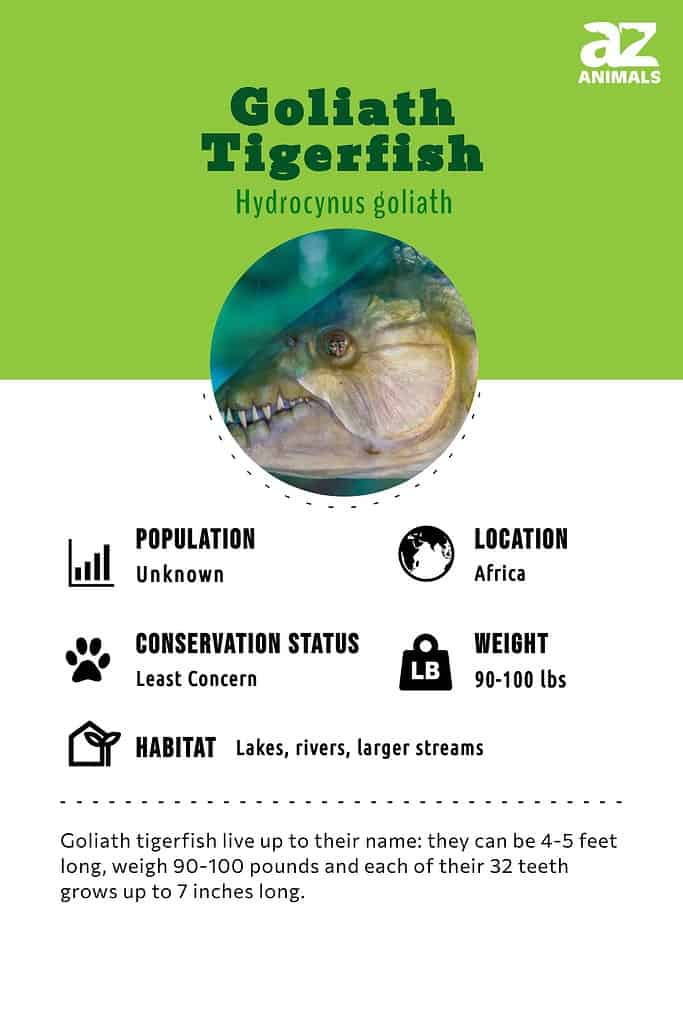
5 Incredible Goliath Tigerfish Facts!
- Owning a Goliath tigerfish in some parts of the world is illegal, including in Florida, where you can’t buy, sell, own, or import them.
- They are sensitive to things like oxygenation, light, and temperature.
- One of its names, M’Benga, means “the dangerous fish” in a Swahili dialect.
- Some Swahili tribespeople believes that the M’Benga evil spirit enters the tigerfish, causing it to attack people.
- Their bite force allows them to cut their prey in half easily.

Fully grown Goliath tigerfish are 4-5 feet long and can weigh 90 to 100 pounds.
©iStock.com/David_Pibrac
Scientific Name
Goliath tigerfish are the largest members of the five species in the genus Hydrocynus. The first part of its scientific name, Hydrocynus goliath, comes from Greek, meaning hydro (water) and kyon (dog). However, some French-speaking African cultures call this fish “Poisson Chien” (dogfish) instead of tigerfish.
Evolution and Origins
The Goliath tigerfish is a member of the Alestidae family that is exclusively present in Africa and includes the Congo tetra and African tigerfish. It belongs to the Characiformes order, which includes more than 2,000 different species and its oldest member Santanichthys can be traced to the early Cretaceous (Albian stage) period 113 million years to 100.5 million years ago.
The Goliath tigerfish is believed to have split from the genus Hydrocynus tigerfishes about 11 million years ago and created its own separate lineage.
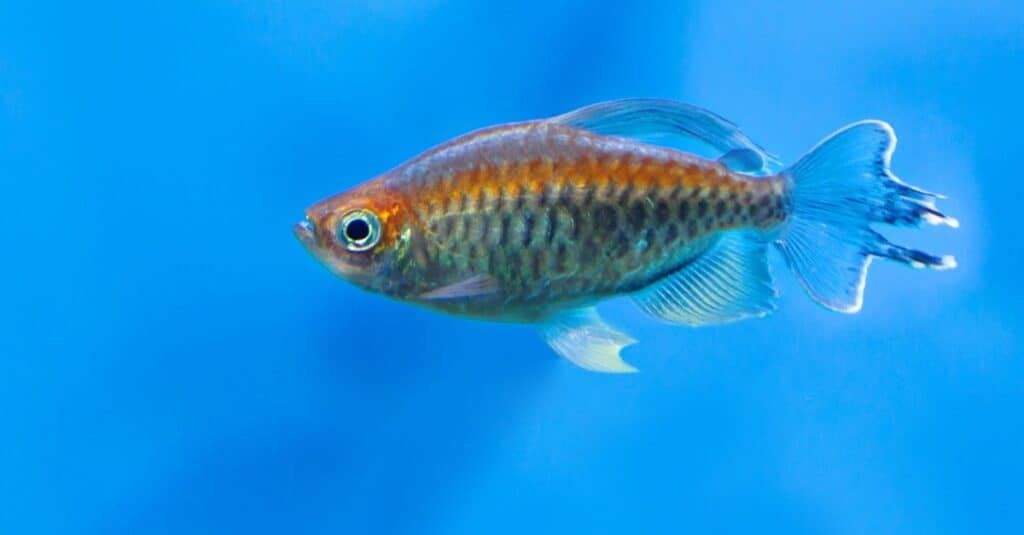
The Goliath tigerfish belongs to the same family as the Congo tetra.
©iStock.com/User10095428_393
Appearance
Goliath tigerfish are primarily olive on top and silvery on the bottom, but you will also find gradations of yellow, brown, and gray with a golden appearance around their faces. They also have an upright dorsal fin and three smaller fins below their bellies. Fully grown tigerfish are four to five feet long and weigh 90 to 100 pounds. Each tooth in the Goliath tigerfish’s mouth can be up to seven inches long, rivaling the size of teeth in many sharks.

Each tooth in the Goliath tigerfish’s mouth can be up to seven inches long.
©Danny Ye/Shutterstock.com
Habitat
This tigerfish species lives in larger rivers and lakes in the Congo River basin, including Lualaba River, Lake Upemba, and Lake Tanganyika. Africa is their sole habitat. As they are numerous in their native habitat, their conservation status is of Least Concern.
Experts recommend that only experienced aquarists keep Goliath tigerfish as pets in a home aquarium because of their aggressiveness. They are usually sold as juveniles, only three to six inches long, yet they require a large tank to grow properly. As these fish mature, you may have to eventually move them from an aquarium to a pond. Nevertheless, they won’t reach their biggest size as they would in the wild. You should not keep Goliath tigerfish with other smaller fish as they will view their tank mates as food and eat them. They require water that is well-oxygenated with a moderate to strong current as they are sensitive to water quality.
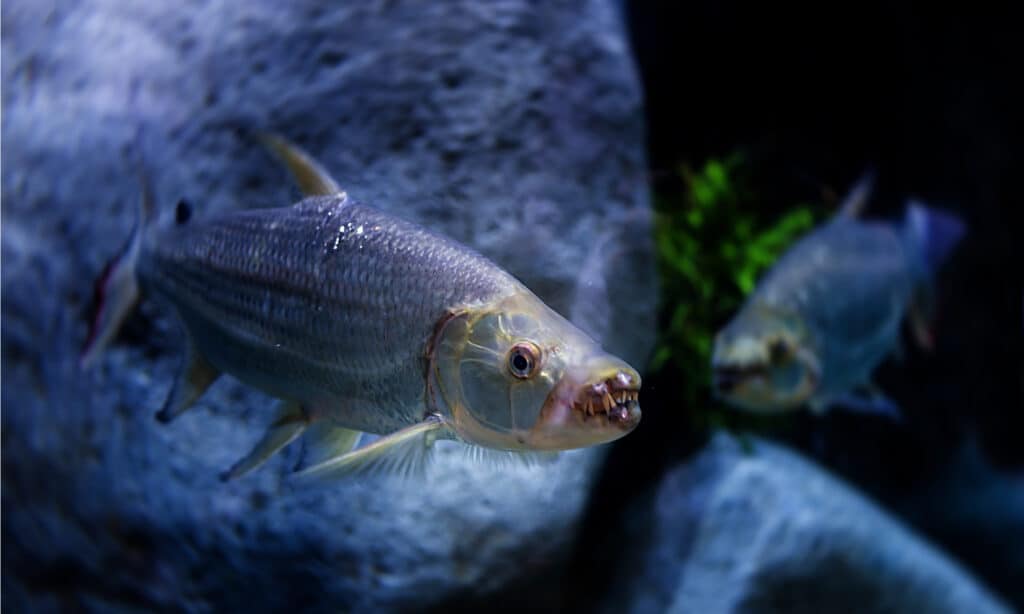
Only experienced aquarists should keep Goliath tigerfish as pets.
©JAKKAPAN PRAMMANASIK/Shutterstock.com
Diet
Goliath tigerfish are apex predators, meaning they have few animals that hunt them. When hunting, Goliath tigerfish use calmer eddies of rivers and lakes to ambush their prey. While these fish use their keen sight to detect their meals, they also have a unique ability to detect low-level frequencies allowing them to sense when prey is nearby. Scientists also believe these fish use their powerful bite force to stun and kill their prey. They don’t use their massive teeth for chewing. Once they kill their prey, they swallow it whole. They hunt catfish, angelfish, cichlids, and gobies.
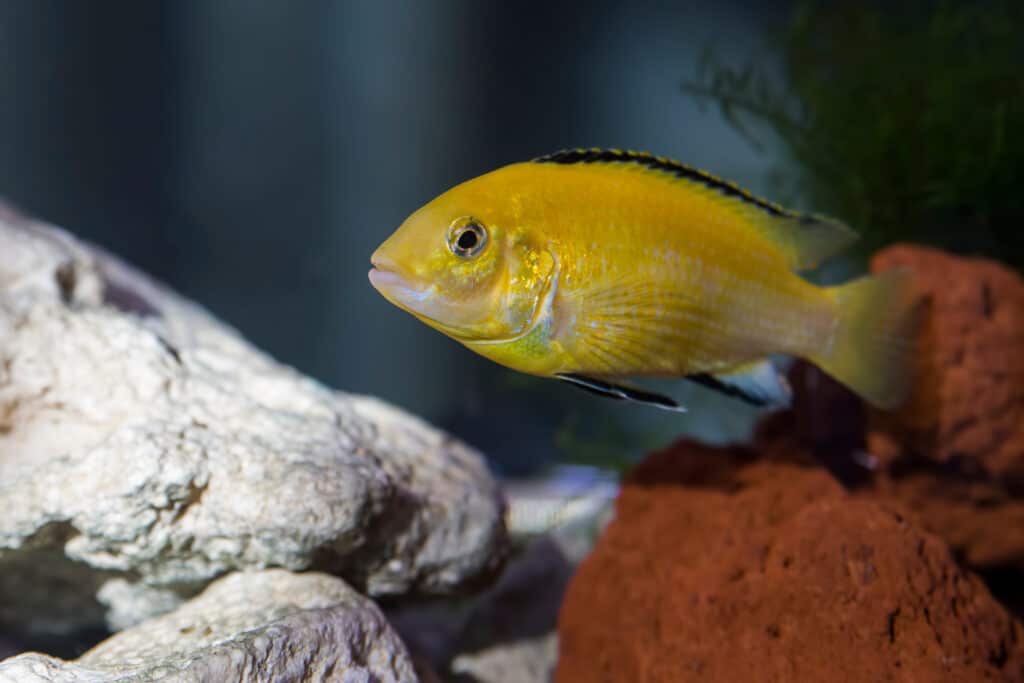
The Goliath tigerfish’s diet includes fish such as cichlids.
©Mircea Costina/Shutterstock.com
Predators and Threats
Although one is a fish and the other is a reptile, Goliath tigerfish and crocodiles share several characteristics. Both are fierce predators known to attack humans. They also have sets of long, pointed teeth. However, freshwater crocodiles are much bigger and stronger than Goliath tigerfish. The size of freshwater crocodiles averages from six to ten feet, while Goliath tigerfish top out at about four to five feet. In a fight between two fully grown animals, the crocodile would win due to its sheer size and strength, but not before losing a few pieces of its skin. Crocodiles will generally play a waiting game with Goliath tigerfish before planting a conclusive bite to kill the latter.
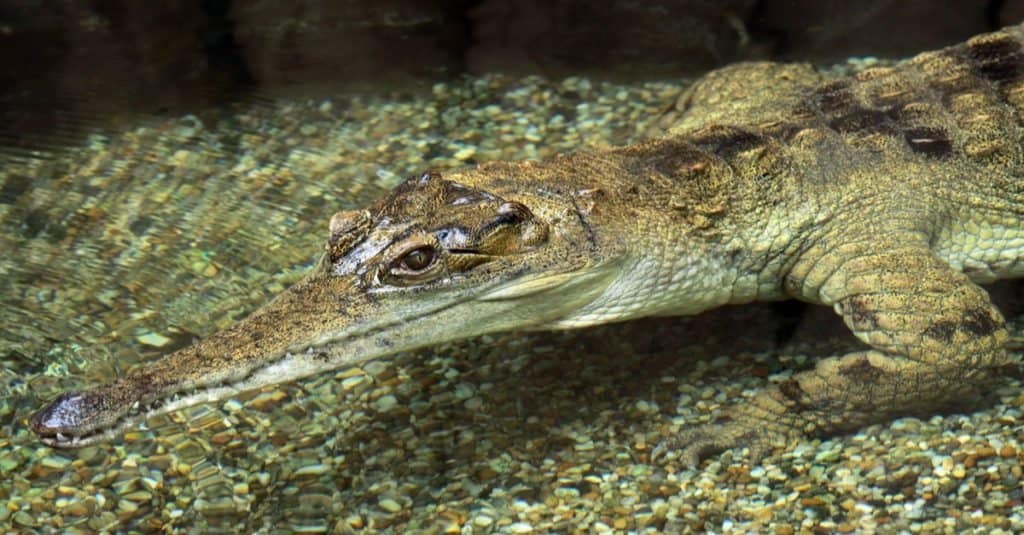
A crocodile such as a West African slender-snouted crocodile is a more powerful predator than the Goliath tigerfish.
©Michal Sloviak/Shutterstock.com
Reproduction, Babies, and Lifespan
Not much is known about how Goliath tigerfish reproduce as scientists have not studied the species extensively. They usually spawn during summer when they find suitable breeding grounds, usually flooded riverbanks, and shores. When they find a suitable spawning ground, female Goliath tigerfish can release up to 780,000 eggs at once. They tend to hide their nests in underwater vegetation, indicating juvenile tigerfish vulnerability. The hatchlings stay there until water levels force them out.
Baby tigerfish feed on plankton and slowly graduate to larger prey as they get older. Goliath tigerfish grow slowly at only four to six inches per year, so they can take up to 10 years to reach their full size. Breeding them in an aquarium is virtually impossible, so all Goliath tigerfish sold as pets are caught in the wild.
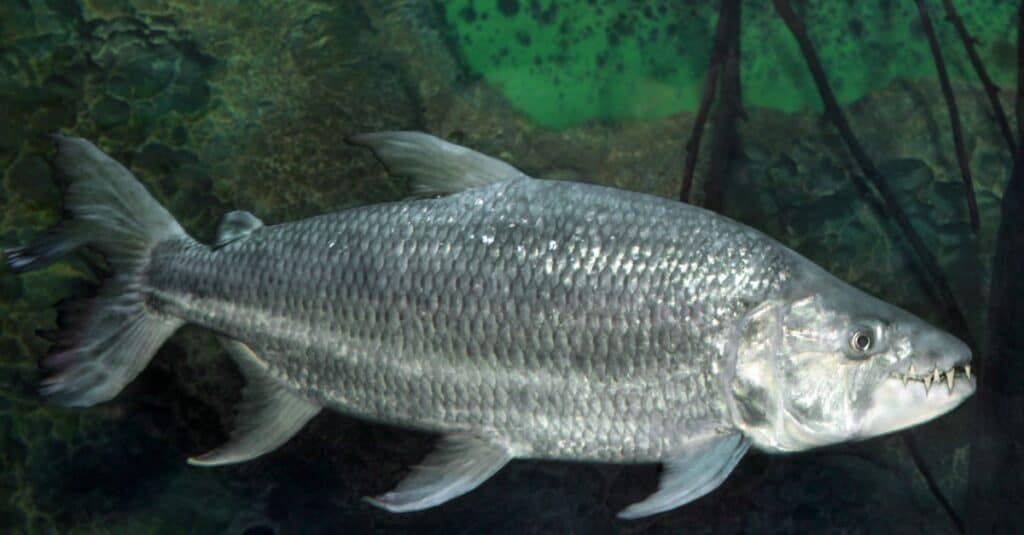
Goliath tigerfish tend to hide their nests in underwater vegetation.
©iStock.com/TatianaMironenko
Goliath Tigerfish in Fishing and Cooking
Goliath tigerfish are considered a sportfishing species primarily. However, these giant fish can feed an entire African village when caught for food. They are whitefish, so their meat is tender and tasty. They are often grilled, fried, baked, and prepared in a similar manner to tilapia. Goliath tigerfish are strong fighters considered to be prized gamefish. They take almost any kind of bait and repeatedly jump when hooked, so a wire leader is necessary due to their sharp teeth.

The Goliath tigerfish can be cooked in the same way as tilapia.
©nednapa/Shutterstock.com
Population and Conservation
There are no specific figures on how many Goliath tigerfish exist in the wild. However, as their International Union for Conservation of Nature Red List status is of Least Concern, one can assume that there are sufficient numbers of these fish in the wild. However, at the same time, local officials in Africa advise sport fishers to release Goliath tigerfish when possible.

The ICUN classifies the Goliath tigerfish as of Least Concern.
©Tobias Arhelger/Shutterstock.com
Goliath Tigerfish FAQs (Frequently Asked Questions)
Do Goliath tigerfish eat humans?
Although there are stories about Goliath tigerfish killing and eating humans in the Congo, none have been substantiated. However, these fish have been known to attack humans, causing substantial wounds due to their bite force. Shiny objects worn by humans may prompt Goliath tigerfish to attack.
How big do Goliath tigerfish get?
As the largest member of the tigerfish family, they can reach a length of four to five feet and weigh as much as 90-100 pounds.
Is the Goliath tigerfish a piranha?
Goliath tigerfish are often considered a bigger and deadlier version of the piranha, yet they are two different species that are distantly related.
What is the biggest Goliath tigerfish ever caught?
The largest one on record weighed 154 pounds.
What do Goliath tigerfish eat?
Goliath tigerfish are piscivores, meaning they will eat other fish. In the wild, they eat catfish, angelfish, carp, cichlids, and gobies.
Thank you for reading! Have some feedback for us? Contact the AZ Animals editorial team.
Sources
- Wikipedia / Accessed April 23, 2022
- Everywhere Wild / Accessed April 23, 2022
- River Monsters / Accessed April 23, 2022
- KnowledgeNuts / Accessed April 23, 2022
- Roaring Earth / Accessed April 23, 2022
- Big Fishes of the World / Accessed April 23, 2022
- Aqua Imports / Accessed April 23, 2022
- Aquarium Part / Accessed April 23, 2022
- NYK Daily / Accessed April 23, 2022
- Unbelievable Facts / Accessed April 23, 2022
- Animal-World / Accessed April 23, 2022
- Springer / Accessed April 23, 2022
- Our Marine Species / Accessed April 23, 2022
- Total Fisherman / Accessed April 23, 2022


















